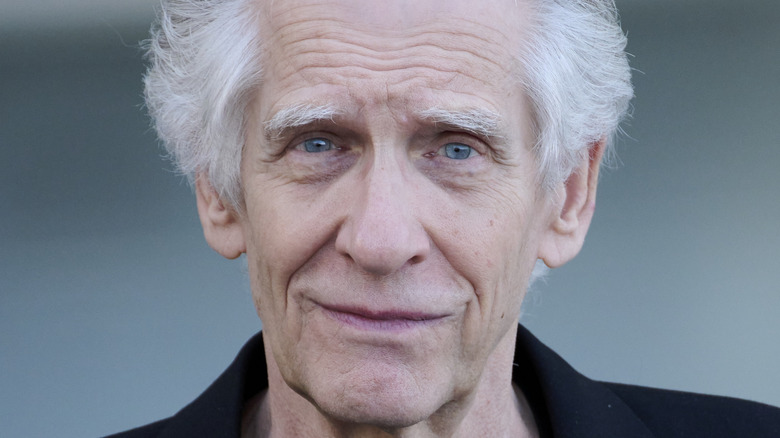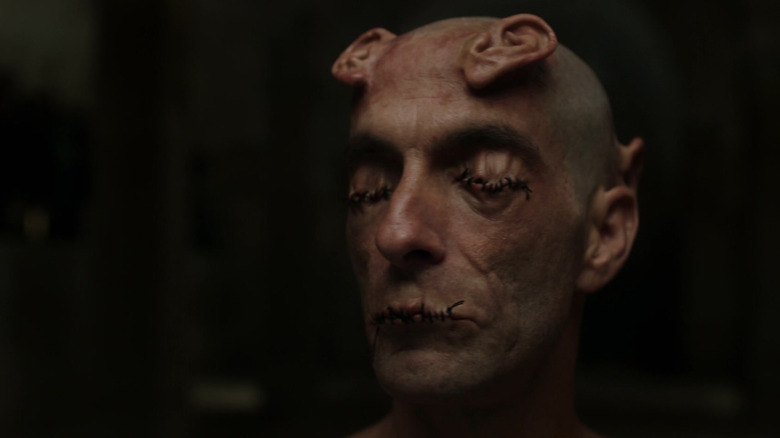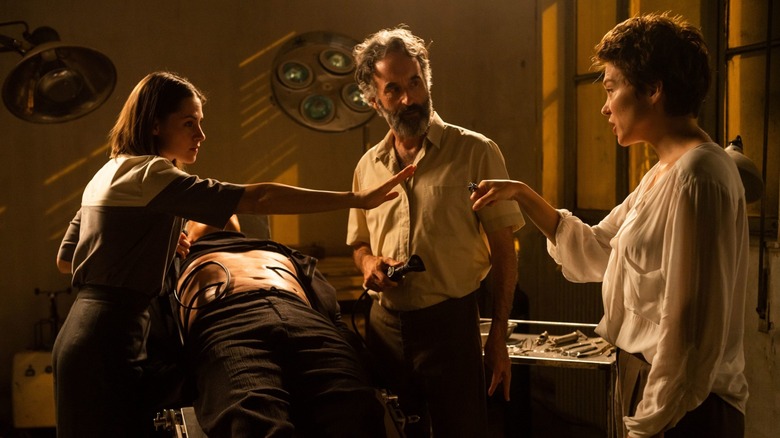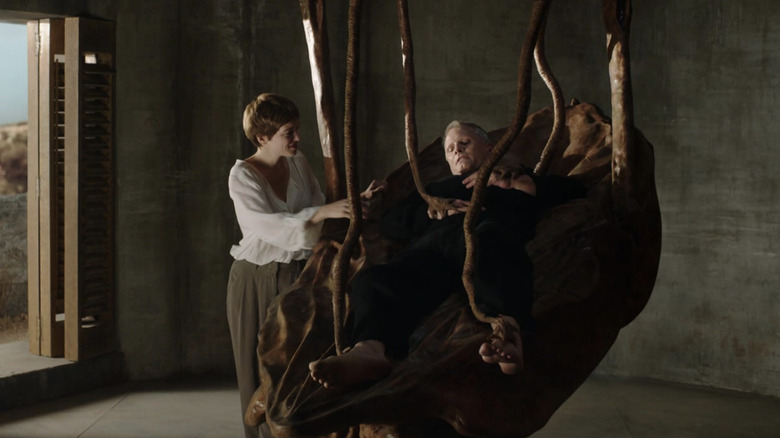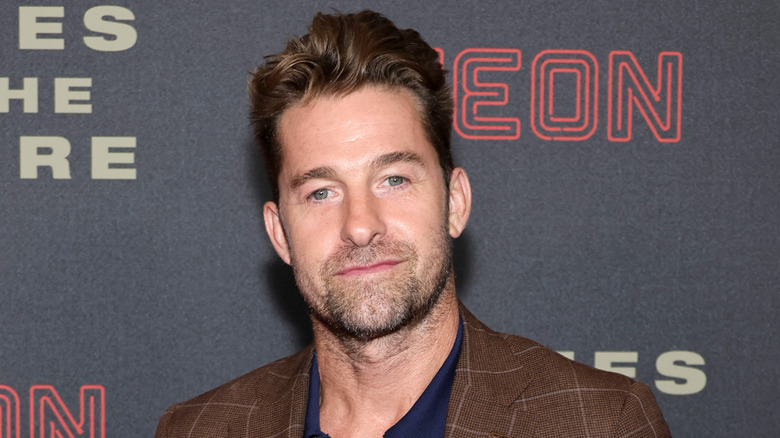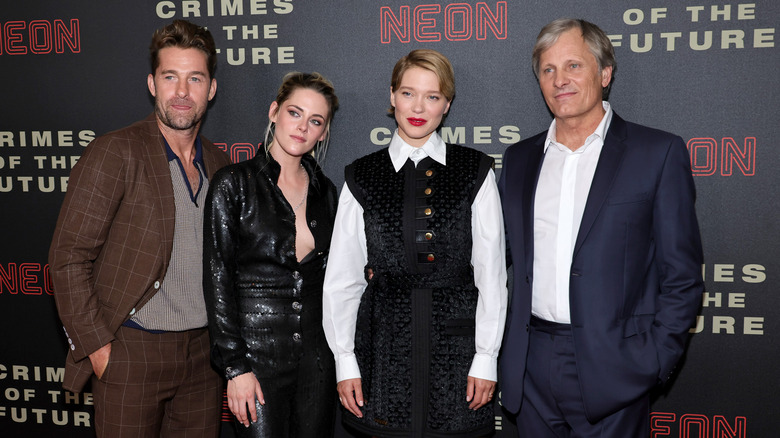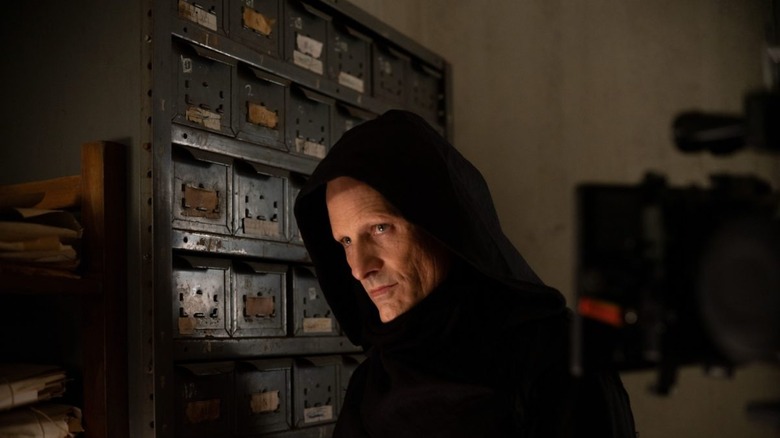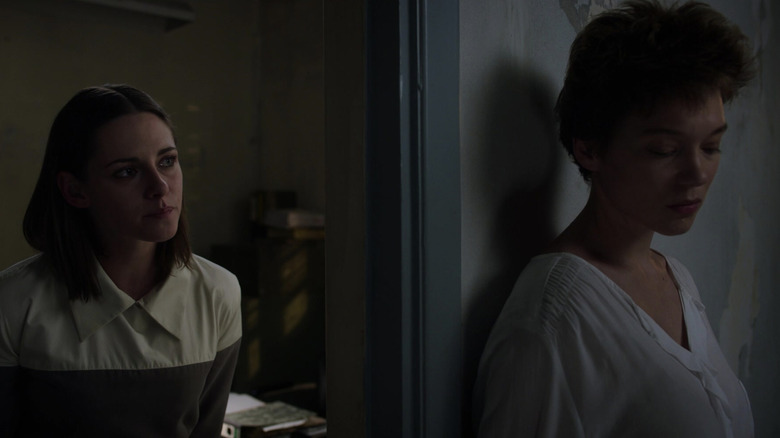The Ending Of Crimes Of The Future Explained
The master of body horror David Cronenberg is back at it with his 2022 feature "Crimes of the Future," which paints a rather macabre picture of what life could be like not too long from the present. The film addresses questions about the nature of human biology, as it shows a world where evolution is occurring at such a rapid pace that there's no longer such a clear line between pain and pleasure.
Both evolutionary and technological developments have removed sensory limitations — such as pain — and opened all sorts of doors in the pursuit of creating art and achieving beauty, no matter how disturbing. "Crimes of the Future" focuses on radical performance artists Saul Tenser (Viggo Mortensen) and Caprice (Léa Seydoux), who push the limits of themselves and their bodies in the name of art.
Like Cronenberg's classic, "The Fly," this tale also centers on a love story. But it is the couple's involvement in the events of the wider world that makes the film another one of the director's great works. After all, underneath the surface of the shocking entertainment on-screen is a deeper layer that explores life's struggle for survival in a rapidly changing environment.
In the world of "Crimes of the Future," radical solutions are proposed that dramatically question themes like the law, healthcare, and even the definition of humanity itself.
The many bizarre aspects of the movie may be difficult to follow, so this guide is here to help understand the story to the very end and possibly beyond.
Grotesque spectacles must be worse than the common bloodshed
In the dystopian setting of "Crimes of the Future," the world has become a darker, filthier place, where graphic images of gore are commonplace. On top of the rampant pollution wreaking havoc on the environment, many human beings have been altered genetically to the point that they no longer feel sensations like they used to.
This has led to all sorts of unforeseen consequences, as people push the limits of what were once taboos. As Wippet (Don McKellar) bemoans in the film, "The world is a much more dangerous place now that pain has all but disappeared."
Viral and bacterial infections are no longer a concern and neither is pain. This has created both a sense of immortality — and the recklessness that comes with it — and a desire to find new sensations beyond pain. Cutting and mutilation — both of oneself and others — are common occurrences.
Entertainment has become more extreme in order to be more interesting than the violence people witness every day, leading to bizarre new crazes like desktop surgery committed out in public. In a society where surgery is the new sex, scenes that used to horrify people have become mundane and so people are searching for the erotic in unexpected new places.
Saul Tenser is an artist in the purest sense
It is revealed early on in "Crimes of the Future" that along with being a famous performer, Saul Tenser is also an undercover informant for Detective Cope (Welket Bungué) of the New Vice law enforcement unit. In one of their first conversations, Saul tells Cope that he hates the Accelerated Evolution Syndrome that his body is afflicted with. He's disturbed by the new organs that grow inside of him and this is the reason he cuts them out.
While Saul may be doing these extreme things to his body out of a personal and emotional need, he is intended to be seen first and foremost as an artist. Whether or not Saul thinks of himself as one, David Cronenberg wanted the character's performative actions to be proof enough of what his true nature is.
In an interview with Variety, the director explained that he viewed his main protagonist as "the artist who is actually giving everything he could give, opening himself up and giving what is the deepest, most intimate part of himself hidden inside. ... And to me, that is the model of a true passionate artist."
Evolution is not about superiority
Throughout the film, governmental authorities like the New Vice body crime unit are trying to snuff out the evolutionary paths that they deem "wrong" based on what they define is the best way for humans to progress into the future. Any developmental trajectories that steer too far away from what they consider "natural" are removed by any means necessary by New Vice. Although, as Detective Cope says, a more accurate name for the agency would be the "Evolutionary Derangement Bureau."
However, David Cronenberg points out that evolution does not work the way that the powers that be want it to and instead, evolution is a process for life to adapt to its environment in ways that are not always glamorous.
In an interview with Variety, the director explained, "When Darwin talked about evolution, he wasn't talking about it leading gradually to something superior. Evolution does not mean going to something better, it means something different." While New Vice and the government believe they are pursuing the most natural path, they are, in fact, going against nature by rejecting evolution that they do not agree with.
Djuna may never face justice for her vile crime
"Crimes of the Future" begins with the tragic murder of Brecken, a young boy, whose mother Djuna (Lihi Kornowski) kills him because he eats plastic instead of regular food. Shortly after, Djuna is taken into the custody of law enforcement. She's there for the rest of the film but doesn't get charged with anything, even though she confessed to the crime.
Considering the governmental authorities are willing to do whatever it takes to put an end to any rejected evolutionary offshoots of humanity — like eating plastic — it is very likely that Djuna may never face justice for the murder of her son.
If law enforcement did follow through with the charging and convicting Djuna, details of the case would be released to the public and people would learn about Brecken's so-called "unnatural" ability to consume toxic substances like plastic. The community of plastic-eaters is still somewhat underground and the authorities don't exactly want this knowledge entering the mainstream, so it's preferable to not charge Djuna at all.
The bionic chairs detect food causing bodily damage
One of the most fascinating aspects of "Crimes of the Future" is the art direction, especially the design of the creepy bionic furniture created by the LifeFormWare corporation. The organic-looking machines are meant to alleviate pain and help digestion, most notably for people like Saul Tenser, who is afflicted with Accelerated Evolution Syndrome.
Yet some major foreshadowing occurs when Dr. Nasatir (Yorgos Pirpassopoulos) is killed by the company agents, Router and Berst (Nadia Litz and Tanaya Beatty), while sitting on the bionic chair, as it's still in operation. The surgeon is taken out for his close involvement with the Inner Beauty Pageant, which accepts evolutionary developments that have been prohibited by the authorities.
Viewers are also given a revealing detail about the common medical equipment in the murder scene. After Nasatir is slain, his lifeless body sits in the now lifeless machine. The fact that the chair is no longer operating shows that a major purpose of the machine is to detect when internal harm is being done to the body. So, it works when characters like Nasatir and Saul attempt to eat normal food, which no longer helps them.
The revelation that standard sustenance is causing harm to people is confirmed at the end of the film when Saul finally gives in and consumes one of Lang's processed bars. As he does so, the chair then stops operating too.
LifeFormWare could not let Lang Dotrice live
The dystopian world of "Crimes of the Future" is crammed with toxic plastic. It's a seemingly insurmountable problem until Lang Dotrice (Scott Speedman) and his movement come up with a solution: They manually alter human bodies to make them capable of consuming and processing the overly abundant plastic as a new form of sustenance.
However, Lang and his followers meet stiff resistance from those in power. The only chance he has of successfully spreading this idea is to expose the natural plastic-consuming biology of his son, Brecken, to the public. He reasons that if more people know about the evolutionary possibility, many would become less resistant to the idea of changing their own bodies.
Brecken's death not only devastates Lang, but it also forces him to change his strategy: He asks Saul Tenser to perform an autopsy of his son that will be broadcast across the globe. Both the New Vice agency and the LifeFormWare company must take action to prevent Lang's plan from succeeding. After all, the powerful corporation that supplies people with bionic beds and chairs would become obsolete if enough people opted to consume plastic instead of using their products to alleviate their health issues.
So, Lang is assassinated by LifeFormWare's agents Router and Berst, even though the risk arises that the radical leader could become a martyr to his people.
Timlin will never seduce Saul Tenser
Throughout "Crimes of the Future," bureaucratic agent Timlin (Kristen Stewart) attempts to seduce Saul Tenser and the two even kiss briefly at one point.
However, if Timlin's eagerness for the "old sex" wasn't enough to put Saul off, her direct involvement in sabotaging Brecken's autopsy shuts the door on their romance for good. Timlin manipulated the insides of Brecken's body, so the world would not learn about his biology and considering her own partner Wippet is so disgusted with her actions, it's not a stretch to think that Saul feels similarly.
Ultimately though, the biggest reason that Timlin doesn't win over Saul is because his heart belongs to Caprice. In an interview with Collider, Viggo Mortensen singled out the "real trusting mutual respect" between Saul and Caprice as the heart of the film, noting, "In the middle of this kind of hardcore movie, there's this very tender, vulnerable love story." Based on these words, it seems unlikely that Timlin or any other woman would be able to get past that bond with Caprice.
Saul Tenser has evolved to consume plastic
Throughout "Crimes of the Future," Saul Tenser is plagued with severe health problems. His body is breaking down more and more until in the film's final moments, he finally eats a bar made of toxic plastic. A single tear streams down his face, as his long suffering has finally come to an end.
The scene proves that Brecken was not the only one to evolve to be able to consume the technological waste, as Saul and many others with Accelerated Evolution Syndrome have the ability sustain themselves from it as well.
The ramifications of the revelation will be immense for the world, as it shows that Brecken is not unique, and it will only be a matter of time before those with the evolutionary traits increasingly discover the truth about themselves and come forward. The more people that reveal their biological nature to the world, the harder it will be for those in power to silence them and control the evolution of humanity.
Lang was right about Saul's true nature all along
During Saul and Caprice's first performance in "Crimes of the Future," Lang Dotrice is in the audience watching the spectacle. So, it makes sense that he then chooses the duo to perform Brecken's autopsy after seeing their impressive Sark unit in action.
Even so, there are many other entertainers that Lang could have approached and would have been willing to do what he asked for the publicity it would bring. This means that there was probably another major reason why he chose Saul.
Since the main focus of Saul's performances is highlighting and then removing the new organs that his body is generating, it stands to reason that Lang suspects that Saul has the same plastic-eating biology as his son but hasn't yet figured it out himself. After all, the ability to eat and process plastic is still hush-hush, so the possibility wouldn't occur to Saul.
If Saul just kept the organs in his body and let them work properly, he would have a much better life, and it seems like Lang is aware of this and wants to help Saul understand it too. In the end, the radical leader was proven to be right, as Saul is now a willing convert to the evolutionists' side after consuming the toxic bar at the end of the film.
Human bodies are passively solving problems we failed to fix
The revelation at the end of "Crimes of the Future" that Saul is also a natural plastic consumer like Brecken means there are probably many more out there, who are also unaware of this potential solution to their condition. Instead of using the bionic furniture from LifeFormWare, people with Accelerated Evolution Syndrome would suffer significantly less if they simply ate plastic and not food that's typically considered normal.
Therefore, a major point of the film is that human bodies are passively solving the environmental problems that people created and then failed to deal with. Since the global populace was unwilling to stop polluting the world with plastic, our bodies adapted to make use of the abundant material.
In an interview with Film Comment, David Cronenberg noted that there are two solutions to the real-life issue of plastic waste. Either every country in the world stops producing plastic and cleans up the environment, or "We find a way to use it to live, as nourishment, as food, as protein." As he notes, each of these solutions is "sci-fi fantastic."
Detective Cope must find a new informant
Detective Cope is definitely going to need a new source of insider information after Saul Tenser's dramatic revelation at the conclusion of "Crimes of the Future." Saul already seemed unwilling to continue working with the authorities after Brecken's autopsy and the discovery that the young boy's body had been tampered with to further the government's own agenda. But after learning of his true nature as well, it would be reasonable for Saul to start considering New Vice and LifeFormWare as major threats.
We can imagine that Saul would no longer want to be a part of the process of eradicating people like him: those with Accelerated Evolution Syndrome, who have given in to their bodies' need for plastic. It is unclear how far he would take his opposition, and if he would fully join the evolutionist rebels originally led by Lang Dotrice. But as a celebrity with a huge following, Saul could make a gigantic impact by sharing the truth with the world.
Will separate human species go to war?
While there's no word on a sequel to "Crimes of the Future," the film has enough details in place to be able to see where the story might go. The film shows us the beginning of the tensions between these two kinds of humans: the "natural" people and the new ones, who have adapted to the plastic-filled world. And as the latter group continues to increase in number, governmental forces would only become more desperate and extreme in their efforts to win the battle over what is considered "human."
Throughout the film, the authorities show they are willing to use deception, infiltration, and even assassination to achieve their objectives, so it is unlikely that there is a line they are not ready to cross if the situation were to deteriorate for them. Unless the evolutionists are completely committed to a peaceful transition, the violence could easily escalate into all-out war between the old and the new humans on earth.
